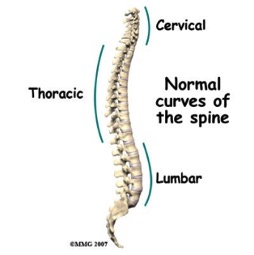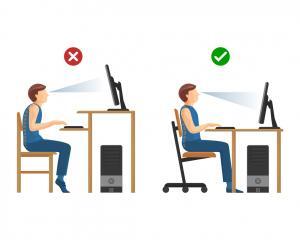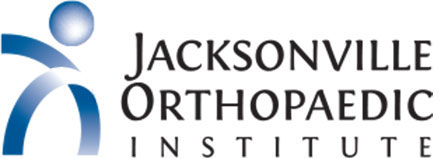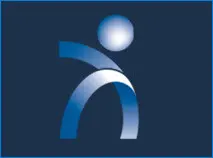Spine Tips
By Jared Ernest Physical Therapist
Spine Tips
Body Mechanics to Prevent Back Pain with Common Activities
This article discusses spine tips for you by JOI Rehab Clinicians. Body mechanics refer to the way we move during every day activities. Good body mechanics may be able to prevent or correct problems with posture (the way you stand, sit or lie). Good body mechanics may also protect your body, especially your back, from injury.

Model of the Human Spine
Using good body mechanics is important for everyone. There are several different types of proper body mechanics during common activities. In other words, things such as lifting, self-care, pushing or pulling, and sweeping or mopping the floor, to prevent back pain.
Neutral Spine Position
It is very important to understand that during daily activities you should be able to always maintain a neutral spine to protect your back. Neutral spine is the position that promotes the natural S-shape curvature of the spine. It is the position roughly midway between a full arch and full rounding of your lower back.
Now, let us talk about the proper way of lifting. The key points to lifting safely are load, lever, lordosis, lungs and legs. You must ensure that the load is manageable or determine the need for another person to assist you with lifting. Always maintain a short lever arm and to be able to achieve this. The load must always be kept close to your body. Important things to remember when lifting from the floor or a lower surface. You should squat or kneel instead of bending on your waist and hold the item close to you. You may need to rest the item on your knee as you transition to a full standing position from kneeling. If squatting, place the object that you are trying to lift between your knees in preparation of the lift.
Correct Way to Lift
Maintain the natural S-shaped curve of the spine and tighten your core muscles as you lift. Do not hold your breath and exhale as you lift the object. Always use your leg muscles for safe lifting and never depend on your back muscles to do the work. You should never bend forward on your waist to pick up items from the floor or from a lower surface.
It is important to never twist your spine especially if you are carrying a load. Therefore, this increases the compressive forces on your spine thereby resulting to injury. If you must turn the item, pick up your feet, step and turn around to avoid twisting your back.
Click to Learn more about Lifting and Bending Properly.
Improper Lifting Techniques
When you are lowering a load to a lower surface, bend on your knees and do not use your back. If lifting overhead, use a stool to bring you closer to the desired height of the object. Therefore, you should always keep the object in front of you.
Another way of lifting small objects from the floor or a lower surface is the golfer’s lift. In order to perform this lifting technique correctly, you need to maintain a neutral spine. As you try to pick up the object from the floor, bend over on your hip (and not on your waist). Lift the opposite leg to counterbalance and maintain proper spinal position. You may choose to hold on to a stable surface with the non lifting hand if you feel unbalanced.

Pain in low back from improper lifting techniques
When carrying an object, hold the object firmly and make sure that the object is close to your body. Do not carry things that are too heavy for you. Always ask for help to move heavy objects. There are many devices available to help carry heavy objects. In pushing or pulling, use the weight of your body to help push or pull an object. Your feet should be apart as in the standing position. Keep your back straight. Lower your body and get close to the object. Bend from your hips and knees. Do not bend on the waist. If the object you are pulling or pushing is too heavy, ask someone to help you. There are many devices available to help you move, push or pull heavy objects.
Proper Technique to Carry Objects, Push Objects and Pull Object for Your Back
Now, let us talk about proper body mechanics when doing self-care activities such as brushing teeth or shaving. It is very important to remember to always stand with one foot forward and one hand on surface to offer rest and support to upper back. Never stand and bend over in front of the sink as this strains the back muscles and ligaments resulting to back pain.
Finally, when mopping or sweeping the floor, make sure to keep your back in neutral. Never mop or sweep the floor while your back is rounded. Follow these tips and you will lessen your chances of hurting or injuring your back!
Hot vs. Cold with Back Pain
The question is often asked, “Which is better heat or ice?” The correct answer is, it depends. To fully understand when one should use heat or ice one must understand the purpose, indications, and benefits of each.
Heat is used to relax tissue, increase circulation, and increase tissue temperature. Tissues in the human body have elastic properties. In other words, the tissues in the body have properties similar to a rubber band. To understand the correlation of heat and tissue lets discuss how temperature affects a rubber band. If you take a rubber band and let it sit in the sun for 20 minutes it will become very pliable and stretch better because the elastic properties increase with the increased temperature. If you take the same rubber band and let it sit in a freezer for 20 minutes, it will become very stiff and not stretch much because the elastic properties decrease with the decreased temperature. Heat affects human tissue the same way. When heat is used on the human body it increases the elasticity of tissue.

Ice Bag for the Rice Protocol
Since heat relaxes tissue it is great to use at the site of muscle spasms or restrictions. Since heat increases circulation, it is typically not good to use with an acute injury or at a site of increased inflammation. In fact, using heat with an acute injury or at a site of increased inflammation can actually make inflammation or pain worse at the site because of the increase in circulation. Since heat increases tissue temperature, it is great to use before stretching or working on flexibility because it increases the tissue temperature and makes the tissue more elastic.
When To Use Ice for the Spine
Ice, on the other hand, is to help decrease pain and control inflammation. Typically, pain at an injury site decreases because of the numbing effect of ice. The body’s inflammatory response is a natural way that the body heals an injury. Ice is a vasoconstrictor and will limit any additional bleeding at an injury site. Because ice is a vasoconstrictor, it aids the inflammatory response and decreases swelling. Ice should not be used at the site of muscle spasms or restrictions because it drops tissue temperature resulting in decreased elasticity of tissue which can make muscle spasms or restrictions worse.
The bottom line is, heat and ice are both beneficial in their own way if used when clinically indicated. In understanding how heat and ice work, one understands when they are clinically indicated.

Sitting and standing work station positions
Office Body Mechanics with Back Pain
Back pain is one of the most common work-related injuries and is often caused by ordinary work activities such as sitting in an office chair or heavy lifting. Applying ergonomic principles – the study of the workplace as it relates to the worker – can help prevent work-related back pain and back injury and help maintain a healthy back.
The goal of an ergonomics program in industry is to adapt the workplace to a specific worker, dependent on the job description, required tasks, and physical make up of the employee performing those tasks. Two types of situations typically cause people to begin having back pain or to sustain a back injury while on the job:
1. Non-accidental injury, where pain arises as a result of normal activities and requirements of the task. Poor body mechanics (such as slouching in an office chair), prolonged activity, repetitive motions, and fatigue are major contributors to these injuries. This may occur from sitting in an office chair or standing for too long in one position.
2. Accidental injury results when an unexpected event triggers injury during the task. A load that slips or shifts as it is being lifted, a slip and fall, or hitting one’s head on a cabinet door are typical examples. These accidents can jolt the neck, back, and other joints with resulting muscle strain or tearing of soft tissue in the back.
Ergonomics
People who sit most of the day, such as those who work at a computer while sitting in an office chair, are also at high risk for non-accidental back injury. Office ergonomics, or computer ergonomics, can help minimize the risk of repetitive injury, such as carpal tunnel syndrome, and the risks associated with prolonged sitting in an office chair, such as neck strain, lower back pain, and leg pain.
The solution is simple. Whether you’re sitting in an office chair or standing in a line, change positions frequently. Just move, stand or sit, stretch, or take a short walk. After returning to the standing or sitting posture, use an alternate posture for just a few moments and some of the tissue elasticity needed to protect the joints will return.
To Learn More about Ergonomics, Click HERE.
Tips When You Have Low Back Pain
1. Frequent or repetitive stretching to the end range of motion or awkward, angled postures can bind the joints. Unlike jobs that require long-term seating in an office chair, jobs that require frequent repetitive motion can cause great discomfort. Such jobs involve lifting from the floor, lifting overhead, moving bulky loads, or using rotational force or twisting while handling material and which signal back injuries might be on the way.
2. Heavy loads offer greater risk. If the job requires moving heavy or bulky objects, it is important to have the proper tools or get help.
3. Fatigue from sitting in an office chair for days, from work or from insomnia can make people move more awkwardly. If one is overtired or feels fatigued, it is advisable to avoid lifting heavy objects alone or quickly.
Poor Posture Can Cause Back Pain
Posture is important for sitting in office chairs and at a workstation. Many of us spend hours in front of the computer, resulting in back pain or neck pain. Much of this pain may be avoided by a combination of:
• Adopting a user-friendly workstation by adjusting the office chair, computer and desk positioning
• Modifying sitting posture in an office chair. Many people sit towards the front of their chair and end up hunching forward to look at their computer screen. The better seated posture is to sit back in the office chair and utilize the chairs lumbar support to keep the head and neck erect.

Wrong and right way to sit vector illustrations.
Take Breaks
• Taking stretch breaks and walking breaks if sitting in an office chair for long periods of time.
A consistent, comfortable workstation depends on where the computer screen is situated, where the hands and feet are placed, and the kind of office chair.
• Choose the surface height for the desk (standing, sitting or semi-seated) best for the task to be performed. Architects and draftsman may want a higher surface for drawing while computer entry work could be seated or standing, depending on the need to use other tools or references. The specific height of the work surface will also need to vary based on the height of the individual worker.

Ergonomics in workplace, good posture
• Adjust the seat of the office chair so that the work surface is “elbow high.” A fist should be able to pass easily behind the calf and in front of the seat edge to keep the back of the legs from being pressed too hard and the feet from swelling. Two fingers should slip easily under each thigh. If not, use a couple of telephone books or a footrest to raise the knees level with the hips. The backrest of the office chair should push the low back forward slightly. If these adjustments cannot be adequately made with the existing office chair, a different make or type of chair may be considered.
• Fit the height of the computer screen. Sit comfortably in the newly adjusted office chair. Close both eyes and relax. Then, slowly reopen them. Wherever your eyes initially focus when they open is the place to put the center of the computer screen. You can raise the screen by using books or a stand if needed.
Remember the body is designed for movement, so get up and move! Take advantage of the walk to the water cooler and stretch!
Sleeping Positions with Back Pain
All of us deserve a good night’s sleep. Sleeping rejuvenates our soul and recharges our body after going through our day to day activities. However, people with back pain struggle and find it hard to get comfortable during sleep. I am going to talk about different sleeping positions that are good for the back and as well as those sleeping positions that we need to avoid. First and foremost, I will be discussing sleeping positions that no person with back problems should be in: sleeping on your stomach. You should try to not sleep on your stomach as it creates too much strain on the low back.
When a person assumes an upright position (such as in standing and sitting), the lumbar spine normally curves slightly, creating a slight concavity at the small of our back, which we call lumbar lordosis. When one sleeps on his/her stomach, this normal slight lumbar lordosis increases, thereby, increasing the compressive force on the joints of the lumbar spine. This can potentially cause back pain, or can aggravate an already unhealthy back resulting to increased pain. Sleeping on your stomach also cause the head to turn on either side, thereby unduly twisting the neck in an uncomfortable and awkward position.
Another sleeping position to avoid is sleeping on your side with one knee way higher than the other because this position could bring us to lying on our stomach, which, as I already discussed, is not good for the back.
The Best Sleeping Position
Now let us talk about the ideal sleeping positions that are less stressful to your back. The first position is sleeping on your side with knees slightly bent together and a soft pillow in between the legs. This allows your back to rest in a natural position.
Another position that does not cause too much strain on the back is sleeping on the back with support, such as pillows, under your knees. Allowing your knees to bend slightly (i.e. placing pillows under your knees) decreases your lumbar spine’s lordosis, thereby, decreasing the compressive force on your low back.
Other thing to keep in mind is that sleeping with too many pillows or sleeping on a mattress which is too hard or too soft will not give your spine a good night’s rest. Do not sleep with more pillows than necessary. If one is comfortable, then only have one. Pillows that comprise of rubber, in any form, do not give rest and support to the neck. Firm pillow is the best.
So, the next time you wake up with an ache and soreness on your back, try to remember what we have talked about and change the way you position during sleep and it will definitely make a big difference!
Soft Tissue Mobilization for Back Pain
Back pain can be miserable! Especially if you are at work and a professional massage isn’t an option. The question if often asked, “What can you do for it?” Here are a couple of things that you can do to help relieve your back pain:
• Stretch: Light stretching will help to relieve the tension in the muscles and help restore movement.
• Self massage: A self massage can be great for a quick release of muscle tension. Lightly rub the irritated area in a counter clockwise to a clockwise motion to help stimulate the muscles, a tennis ball can be a great tool to help roll out the sore muscles. Place the ball on your back and lean up against the wall and roll back and forth; this will stimulate the muscles and help reduce the muscles strain.

Soft Tissue Mobs by JOI Rehab
Strengthening for Back Pain
Many patients with back pain try to avoid physical activities due to fear that their condition might get worse or that they may re-injure themselves. This fear results in limited physical activities – either staying in bed or at least stopping any activity that is at all strenuous. While this approach is understandable and may even be recommended in the short term particularly during an acute episode, when done more than a day or two, it can actually undermine healing.
Back Exercises
Instead, active forms of back exercises are almost always necessary to rehabilitate the spine and help alleviate back pain. To understand and appreciate the benefits of exercise in the management of back pain, let us first understand some basic information about the spine. We perform almost all of our daily activities in the upright position (i.e., sitting and standing). Our muscles (the core and deep back extensors) and ligaments support the spine and they provide the stability needed by the spine to maintain its position throughout the day. When the ligaments and muscles are weak, they are unable to hold the spine in good alignment. As a result, the ligaments stretch and this causes pain.
The muscles will try to help, but if the muscles are not strong, they soon weaken and add to the pain by displaying a mild cramp due to fatigue. The best way to alleviate the pain is to get to the cause – and that is, weak ligaments and muscles. Muscles strengthen by exercising them properly. When muscles are strengthened, it will allow the ligaments that are overstretched to heal and recover by taking the stress from them. This is the main reason why strengthening exercise is very important with back pain, and when done in a controlled, gradual, and progressive manner, active back exercises distribute nutrients into the disc space and soft tissues in the back to keep the discs, muscles, ligaments and joints healthy.
Stretching for Back Pain
There are numerous benefits to stretching the musculature and ligaments in the lower extremities, pelvic girdle, and spine. Most everyone will sustain a healthier lifestyle by improving mobility of these tissues. Soft tissue restriction in these areas contributes to increased stress and restriction in the spine, which overtime can complicate or increase neck or back pain. In stretching the musculature and ligaments in these areas, the increase in motion will result in sustained relief of back pain.

JOI Rehab Single knee to chest stretch
There are many things to keep in mind with regards to stretching for back pain. When stretching, wear loose comfortable clothes that allow for easy movement. Stretching should be pain free. There should never be stretching into any sharp intense pain. When stretching, move into the position slowly. There should never be any quick, jarring movements into a stretch, as these quick movements can cause injury. Always stretch on a flat surface with enough area to move freely.
Stretches should always be held for a long static duration rather than short time. It is proven clinically the benefit of static stretching. Although there are many benefits of stretching in regards to back pain, you should always contact a physician regarding your neck or back pain prior to beginning any stretching program to determine which stretches should or should not be done.
Related Article: Lower back anatomy and low back pain and Best Core Stabilization Exercises.
JOI and JOI Rehab
JOI Physicians continue to offer online new patient appointments. This is another option to make it more convenient to make new patient appointments with less phone hold times. Follow the link below to select your JOI MD and schedule online.
You can still call 904-JOI-2000 to make new patient JOI Physician Appointments if that is your preference.
To make appointments with JOI Rehab, please call 904-858-7045.
By: Jared Ernest, Physical Therapist







